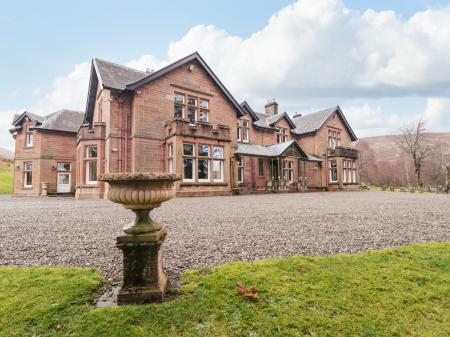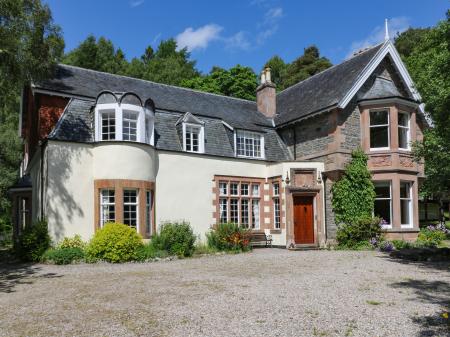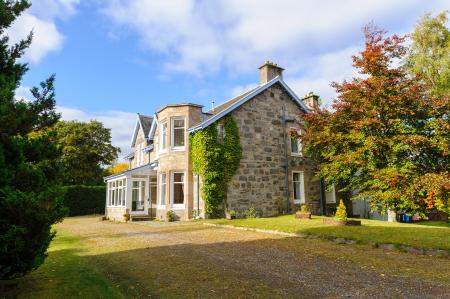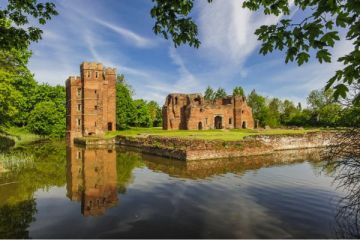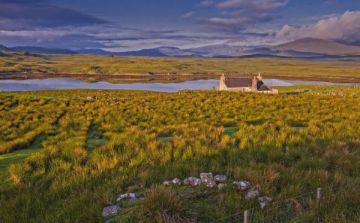If you've ever seen a modern Disney film (or, like me, watched the old Walt Disney Show on television growing up) you'll know that the company logo is a fantasy castle of turrets and towers.
Did you know that Disney's fairytale castle was based on a very real Scottish castle? Though no castle in Scotland can compete with the fantasy Disney castle, a few come close! Here's our look at the best of Scotland's very real fairytale castles.
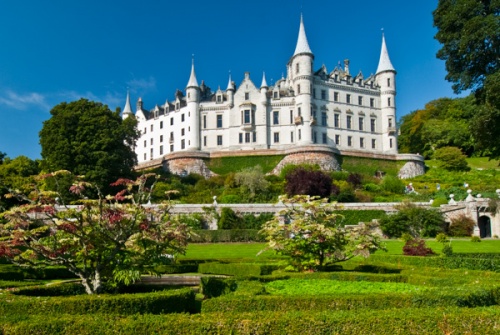
You could argue that most of these castles are stately homes rather than actual castles, though several of them began as medieval fortresses or fortified houses and were gradually remodelled over the centuries to take on a castellated, fairytale look.
1. Fyvie Castle, Aberdeenshire
Fyvie Castle is the perfect Scottish baronial castle, with an entrance defended by a yett, or iron gate. The castle began as a royal lodge, and William the Lion held a Parliament at Fyvie in 1214. Other monarchs to visit Fyvie include Alexander II (1222), Edward I of England (1296), and Robert Bruce in 1308.
The Preston family built the oldest surviving part of the current castle, a tower at the south-east corner. In the 15th century, Sir Alexander Meldrum added another tower at the south-west corner. The Seton family added the impressive main entrance, flanked by drum towers. The Setons supported the Jacobite cause and were outlawed in 1690.
Fyvie then passed to the Gordon family, Earls of Aberdeen, who built another tower. Finally, in 1885 Alexander Forbes-Leith purchased Fyvie. He and his American wife built yet another tower to complete the castellated exterior we see today. They also restored the castle interiors in opulent style.
Fyvie is said to be haunted by at least two ghosts. The 'Green Lady' is said to be the ghost of Lilian Drummond, who was starved to death by her husband in 1601.
The second spectre is dubbed the Grey Lady. In the 1920s workmen doing repairs made a gruesome discovery. They uncovered the bones of a woman who had been sealed inside a wall. The bones were given a proper burial in the local churchyard, but the ghost of the Grey Lady haunted the castle until her bones were dug up again and replaced inside the walls, whereupon sightings of the spirit ceased.
In the superb castle gardens is a special garden area dedicated to a medieval seer named Thomas Rhymer. According to legend, Rhymer was on his way to Fyvie one day when a gust of wind blew down a tree, and he was struck by a falling branch. Rhymer flew into a rage and cursed Fyvie and its owners. The garden is an attempt to mollify Rhymer's spirit and soften the effects of the curse.
Fyvie is simply stunning.
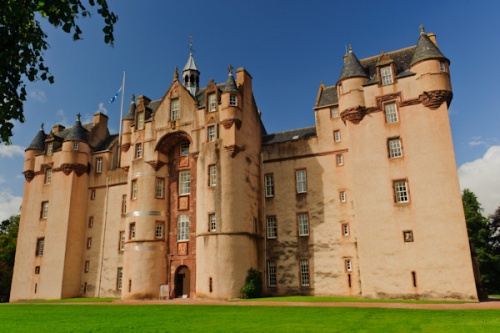
2. Braemar Castle, Aberdeenshire
Braemar Castle is a picturesque fortified tower house beside the River Dee. It was begun in 1628 for the Earl of Mar as a hunting lodge. It also served to defend the Mar estates against the neighbouring Farquharson clan of Inverey.
The castle controlled access through the pass of Glen Derry and through the Cairngorms to Strathspey.
The Earl of Mar's castle was a fairytale fortress on an L-plan, with battlemented towers and turrets protected within a star-shaped curtain wall.
In 1689 'Bonnie' Dundee tried unsuccessfully to capture the castle. The government came to the Earl of Mar's aid by sending royal dragoons to defend Braemar. But they could not protect the castle against John Farquharson, the 'Black Colonel' of Inverey.
Farquharson attacked Braemar Castle and forced the government soldiers to flee. He then burned the castle to the ground. But it would not be long before the Jacobite cause called Braemar Castle to war. In 1714 George I came to the throne and immediately dismissed many of the most powerful ministers in the previous government. Among them was John Erskine, Earl of Mar.
The Earl was livid, and the following year he the Earl of Mar raised the Jacobite standard at Braemar and proclaimed James VIII and III as the rightful king of the realm. Alas for the Earl, the Jacobite Rising was short-lived and he was forced to flee into exile. The castle was now almost ruinous, but rescue was at hand. The Farquharson family purchased it in 1732.
The new Farquharson laird refused to take part in Bonnie Prince Charlie's 'Forty-Five' rebellion, and as a result, Jacobites burned the estate. The Farquharsons had had enough. The laird moved to Edinburgh and leased the castle to the crown.
Thankfully, the government did not let Braemar Castle decay, but called upon John Adam, one of the foremost architects of the day, to restore and refurbish the upper floors. The result is a delight.
Highlights include the 18th-century kitchen and 'laird's pit' or dungeon, the dining room and drawing rooms on the first floor, and family bedrooms on the second floor.
Braemar Castle is said to be haunted by the ghost of a new bride, who thought, wrongly, that her husband repented of their marriage and had deserted her. She cast herself off the top of the castle in despair, and today her spirit is said to haunt the grounds.

3. Craigievar Castle, Aberdeenshire
Craigievar Castle is said to be the inspiration for the Disney fairytale castle, and when you see it you will know why Walt Disney used it as the model for his imaginary medieval castle.
However, Craigievar is not a castle at all but a fortified tower house dating to at least the 14th century. The Mortimer family owned the Craigievar estate from 1376, but it was not until 1575 that Sir John Mortimer transformed the medieval family home into the impressive tower house we see today, with its proliferation of towers and conical turrets.
Sir John's house began as a fairly plain design, rising in straight lines to the height of the 4th storey. The Mortimers were a Catholic family, so Sir John built a chapel into the house, but made sure that no trace of it could be seen from outside.
In 1610 Craigievar was purchased by William Forbes of Menie. Forbes had made a fortune by importing wood from the Baltic region. In pursuit of his business he visited the Baltic port of Danzig so often that he became known locally as 'Danzig Willie'. Forbes married Margaret Woodward, and their initials can be found throughout the castle.
Danzig Willie removed the upper floors of Craigievar and rebuilt them on a grand scale. The upper floors have a larger footprint than the lower floors, so he used a system of elaborately carved corbels to support the upper chambers, which he topped with conical turrets and viewing platforms with balustrades. The effect is stunning and combines traditional Scottish architecture with Renaissance style.
Forbes decorated the interior of his mansion with ornate plasterwork ceilings embellished with heraldic symbols.
One of Danzig Willie's descendants was 'Red' Sir John Forbes, his grandson, whose moniker referred both to his red hair and his violent temper. That temper gave Craigievar its resident ghost.
According to the tale, Sir John's daughter fell in love with a member of the Gordon family, old enemies of the Forbes clan. The suitor snuck into Craigievar for a romantic tryst by climbing the castle wall to the Blue Bedroom on the fourth floor.
Instead of the laird's daughter, he was confronted by Red Sir John, who put a sword to the young man's throat and forced him to jump from the window. The young man died from the fall, and ever since that fateful night ghostly footsteps can be heard crossing the Blue Room to the window.

An unforgettable fairytale castle is an equally unforgettable setting, Inveraray Castle has been the seat of Clan Campbell since the 15th century. The castle is set in an idyllic landscape beside Loch Fyne.
In the mid-15th century, Sir Duncan Campbell moved the Campbell family seat from the head of Loch Awe to Inveraray on Loch Fyne, where he built a small castle.
That medieval fortress was essentially unchanged for over two centuries before the 2nd Duke of Argyll decided that he needed something grander to reflect his wealth and status.
The amazing concoction of Gothic, Baroque, and Palladian style we see today is the result of an idea sketched out by John Vanbrugh, the architect of Blenheim Palace, for the 2nd Duke. Unfortunately, Vanbrugh died before building could begin. It was left to the 3rd Duke to call upon William Adam and Roger Morris to design the new family seat.
Construction on Inveraray Castle began in 1743 but was not finished for another 43 years. Morris and Adam died long before the castle was completed, so the work was finished by Adam's famous architect sons, John and Robert.
The castle is built on a rectangular plan with a crenellated tower at the centre and circular towers at each corner. The new house bristles with mock-military features including turrets, moats, and slit windows.
The Dukes of Argyll lavished money on Inveraray, prompting Dr Johnson to write, 'What I admire here, is the total defiance of expense'. The Dukes had the town of Inveraray torn down and rebuilt in its present location to provide an uninterrupted view from the house.
The castle interiors are meant to impress and awe visitors. The Campbells wanted visitors to be overwhelmed by their family home, and it shows.
The interiors feature a fabulous collection of furniture, tapestries, fine art, and stunning plasterwork ceilings. Look for the Tapestry Drawing Room, with ornate 1773 ceilings made of papier-mache.
Inveraray Castle is extraordinary.

5. Ballindalloch Castle, Aberdeenshire
Ballindalloch Castle is a romantic castellated house in the heart of Aberdeenshire's whiskey country. The fairytale castle has been dubbed 'The Pearl of the North' for good reason. It has been the home of the Macpherson-Grant family since 1546.
The core of Ballindalloch is a z-plan tower house. The fortified tower house was badly damaged by the Marquis of Montrose following the Battle Inverlochy in 1645, and it was transformed in the 1770s by Colonel James Grant, a career soldier and diplomat. Grant must have considered himself a man of taste and culture; he set aside an entire wing of the house for his French chef.
Ballindalloch is where Aberdeen Angus cattle were first bred, and you will often see cattle grazing in the fields just beyond the house.
The interiors of Ballindalloch are sumptuously furnished and feature a wonderful collection of 17th-century Spanish paintings.
You might wonder why the castle was built in such a low-lying position near the confluence of the Spey and Avon. According to legend, the Macpherson-Grant laird began to build on a hill overlooking the river, but his unfinished house was blown down in a gale. The laird then heard a voice telling him to build in the 'coo-haugh', or cow meadow, beside the river. He followed the mysterious message and Ballindalloch is the result.

Glamis Castle (pronounced 'Glams') is the childhood home of Elizabeth Bowes-Lyon, the former Queen Mother. But there is much more to Glamis than its royal associations.
The castle dates to at least the 14th century when Robert II of Scotland gave the estate to John Lyon, the 1st Lord Glamis. Lyon built a fortified tower house, replacing an earlier house on the site. This late 14th-century tower house still forms the core of Glamis Castle today.
Centuries of remodelling and enlarging the tower house created the large, castellated mansion we see today. Glamis Castle looks like a French chateau, all towers and conical turrets. The interior is superbly decorated in opulent style, with the lion symbol of the Lyon family decorating every chamber except the chapel.
Glamis is reputed to be the most haunted castle in Britain. Among the various ghosts reported are those of two gamblers destined to play cards forever because they dared play on the Sabbath. another ghost is said to be the spectre of Janet Douglas, Lady Glamis, who was executed on a trumped-up charge of being in league with the devil.
According to Shakespeare, Glamis Castle is the place where Macbeth murdered King Duncan in order to take his place on the throne. It is a good story, but Duncan actually died in battle near Elgin. A king was murdered at Glamis, but it was King Malcolm II, who was killed in 1034 (but not by Macbeth).

Blair Castle is the most heavily visited historic house in Scotland, a testament to its rich history and exotic appearance. The castle dates to the 13th century and was built to control access through Strath Garry between Inverness and the Cairngorms.
The earliest part of Blair Castle is the Cummings Tower, built in 1269 by the Comyns of Badenoch. Unfortunately for the Comyn family, they did not own the land. It was owned by the Earls of Atholl, who swiftly evicted the Comyns and took over possession of Blair Castle. The Atholls have resided here ever since - a span of over 750 years.
Blair Castle was captured by Oliver Cromwell in 1652 and only restored to the Atolls after the Restoration of the Monarchy in 1660.
The Dukes of Atholl supported the government during Bonnie Prince Charlie's 1745 Jacobite Rebellion. Jacobite troops marching to Culloden besieged Blair Castle in 1746. This is the last siege on British soil. By that time various Earls and Dukes had transformed the earlier tower house into a fashionable country house.
It was transformed again in the 1860s when the 7th Duke renovated it in Scottish Baronial style. Interior highlights include a display of weapons used at Culloden. Look for the Tapestry Room, hung with Mortlake Tapestries once owned by Charles I.
Blair Castle is home to the Atholl Highlanders, which began as the only [legal] private army in Britain, but is now a ceremonial bodyguard.

8. Castle Fraser, Aberdeenshire
Castle Fraser was begun in 1455 by Thomas Fraser, who called his fortified tower house the Castle of Muchil-in-Mar. In 1575 Michael Fraser of Stoneywood rebuilt the earlier tower house as a much larger Z-plan house.
Michael Fraser's building scheme was so ambitious that the house was not finished until 1636, over 60 years later.
The man responsible for finishing the castle we see it today was master mason John Bell, who was also responsible for Craigievar and Crathes castles.
In 1814 Col Charles Mackenzie Fraser transformed his ancestors' tower house complex in late Georgian style and remodelled the interior. Thankfully, later owners removed the Colonel's 'improvements' and restored the castle to its historic roots.
Unlike many similar fortified houses in Aberdeenshire, Castle Fraser has never needed to use its military features for defence and has never had to withstand a siege. By comparison to some stately homes, the chambers on view to visitors are relatively small, but that helps give Castle Fraser a very intimate, welcoming feel.
This is very much a family home, not a showpiece. The interior furnishings are interesting, not luxurious, and there are fascinating exhibits on the long history of the Fraser family.
In the grounds is a very attractive walled garden, and there are walking trails around the estate.

Dunrobin Castle looks for all the world like a medieval fantasy, or a Holywood version of a French chateau magically transported to the north-east coast of Scotland. You could argue that it isn't a castle at all, but a stately home in castellated style.
But that exotic French exterior is deceptive, for at the heart of Dunrobin Castle is a 13th-century stone keep. The origins of Dunrobin go back even further to the 12th century when the Norman knight Freskin de Moravia was granted land in Sutherland for his role in helping David I and William the Lion gain control of the northern Highlands.
Freskin's grandson was named the 1st Earl of Sutherland in 1235 but the oldest parts of the present palatial residence date to the 1320s, during the rule of the 3rd Earl. A stone keep was built in 1401, defended by a yett; an iron gate like a portcullis on hinges.
But the medieval roots of Dunrobin are largely hidden beneath a remarkable French-style chateau created by Sir Charles Barry from 1845. Barry, who was known for his Gothic Revival designs, was tasked with creating something completely different; a French fantasy castle on the edge of the North Sea. He succeeded magnificently.
In 1746 Dunrobin Castle was caught up in the tumult of the Jacobite Rebellion. The Earl of Cromartie, a Jacobite supporter, heard the news that Bonnie Prince Charlie had won the day at the Battle of Culloden (in fact, he had been utterly routed). The Earl marched on Dunrobin and captured it in the name of the new Stewart monarch. When reports of the truth emerged the Sutherland militia attacked the castle and seized the Earl. The room where he was captured is known to this day as the Cromartie Room.

Falkland Palace began as a simple 12th-century hunting lodge owned by the Macduff Thanes of Fife. The lodge was destroyed by English soldiers in 1337, but it was rebuilt. It really came to prominence under Robert Stewart, Duke of Albany, who took control in 1371.
Albany was the most powerful man in Scotland, a law unto himself. He imprisoned his nephew, the Duke of Rothesay, at Falkland where the unfortunate youth was starved to death in a cellar.
When Albany was ousted from power in 1424 James II seized Falkland for the Crown and transformed the fortified keep into a comfortable residence for his wife, Mary of Gueldres.
Over the following century Falkland Palace became a country retreat of the Stewart kings and queens, a place where they could escape the rigours of court life and enjoy pursuits such as hawking, hunting and archery.
They also played 'real' tennis, and Falkland possesses the oldest real tennis court in the world, built in 1539. Mary, Queen of Scots enjoyed the game enormously and used to scandalise her courtiers by wearing men's breeches to play the game.
When James VI took the throne of England as James I, Falkland fell out of favour as a royal retreat. It was simply too far from the court at London. The 3rd Marquis of Bute restored the Palace in the late Victorian period, and today the Palace is preserved by the National Trust for Scotland.
Highlights include the royal apartments, where you can see James VI's canopied bed and the bed where James V died. The Chapel Royal is among the finest pre-Reformation chapels in Scotland.

For more inspiration, see our guide to Scottish castles and our list of stately homes in Scotland.
And the next time you see that Disney logo, think of the very real fairytale Scottish castles that inspired it!
MOST POPULAR POSTS
